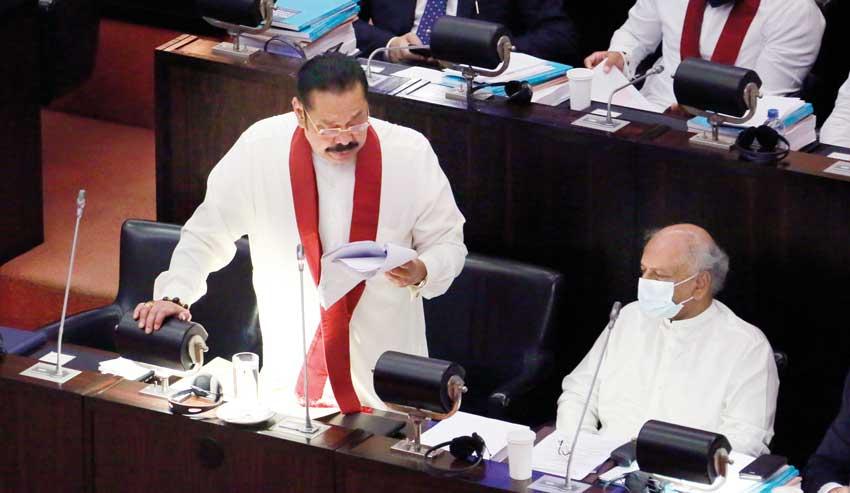Reply To:
Name - Reply Comment

Prime Minister and Finance Minister Mahinda Rajapaksa presenting the Budget for 2021 in Parliament
Moody’s Investors Service in a report issued yesterday said, “Sri Lanka’s 2021 budget highlights the ongoing fiscal challenges and is unlikely to significantly boost growth,”indicating that the change of opinion between the government and the rating agencies at large over the country’s growth path, will continue post budget.
Moody’s said the budget’s growth focus will not provide meaningful boost to the output while the increased spending will add to the fiscal pressure, which is a credit negative.
The government projected the fiscal deficit at 8.8 percent of the gross domestic product (GDP) for 2021 reinforcing its commitment to a medium term fiscal consolidation path to bring the deficit down to 4.0 percent by 2025 backed by continuous economic growth.
Moody’s showed that the budget 2021 calls for Rs.3.6 trillion in expenditure, a 26 percent of increase from the estimate for 2020, but failed to say that the government is proposing to cut fiscal profligacy by way of reducing the recurrent expenditure to 14.4 percent of the expected GDP in 2021 from 15.3 percent of GDP in 2020.
“We expect the government to face challenges in rationalizing government spending and delivering fiscal consolidation post-coronavirus, as a large interest bill, rigid public sector wages, and subsidies and transfers keep recurring government spending elevated,” the rating agency wrote.
Further, the overall expenditure for 2021 is higher because the budget has allocated 6.1 percent of GDP for public investments, which has the potential to generate revenues in the future, compared to 2.6 percent in 2020.
“But despite the focus of the development-oriented budget on reviving economic growth and reducing poverty, the benefits will be limited by the magnitude of the pandemic-driven hit to demand for Sri Lankan exports and the collapse in tourism activity.
Domestic demand is also likely to remain sluggish given still-subdued business and consumer confidence, and ongoing import restrictions affecting industries such as construction and manufacturing,” Moody’s said.
However, analysts point out that this is precisely why the government needs to loosen its purse strings to support the revival of the economy beset by the pandemic, and help the private sector navigate through the pandemic until it can stand on its feet.
In fact, this is the same policy practiced elsewhere—both developed and developing economies around the world—which are often referred to as ‘government stimulus packages.’ The government last week proposed to extend the debt moratorium on the tourism sector by a further six months till end of September, partly via Treasury guarantees, in what could be the longest debt relief afforded by any government in the world.
It appears that according to analysts at Moody’s, the government spending to ride out the worst crisis since the Great Depression, is financially imprudent and therefore credit negative.
Their narrative, as explicit as it could be is to tighten the government purse strings no matter how much suffering the pandemic inflicts on the domestic economy.
Presenting the same chart on foreign debt obligations falling in due every year through 2025, the rating agency repeated its claim that Sri Lanka on average has about US$ 4.5 billion in debt repayments and, “elevated repayment risks will continue to raise pressure on the government’s external and liquidity position as the recovery in major sources of foreign exchange earnings is likely to be slow, keeping the country’s international reserves position thin.”
However, raising debt denominated in foreign currency could become relatively easier than prior to the pandemic as global yields hover near zero levels. A convincing growth story backed by political stability and higher growth could draw foreign investors towards bonds.
Sri Lanka expects to expand the economy by 5.5 percent in 2021 from a contraction in 2020, but Moody’s appears to be struggling to see a world beyond COVID-19.
“We expect Sri Lanka’s economy to contract by more than 3 percent in 2020, with prospects for a gradual rebound in 2021 increasingly at risk given renewed virus flare-ups and lockdown measures globally.”
The budget 2021 was hailed across local business circles, first for giving them the much-needed predictability via maintaining the tax policy and second, the policies enunciated for enterprise renaissance, which could bode well for job creation, stronger domestic industrial base, market access, and higher income generation.
Moody’s in September downgraded Sri Lanka by two notches Caa1, from B2, citing wide budget deficits, slow reforms and weak institutions.